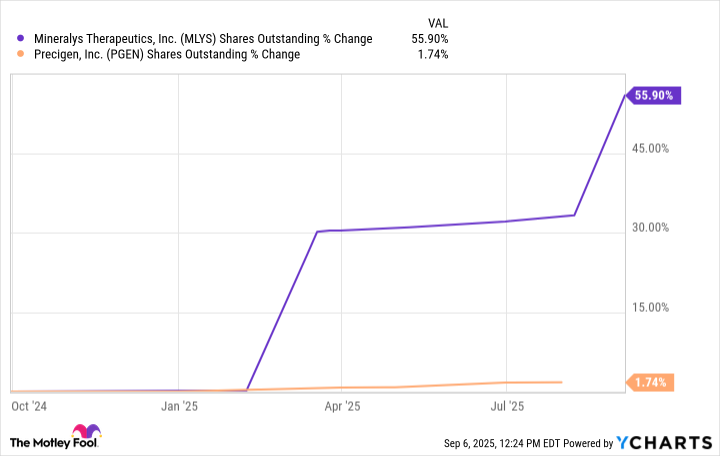2 Ultra-High-Yield Dividend Stocks With Total Return Potential of Up to 41% in 12 Months, According to Select Wall Street Analysts
Juicy dividends are only part of the attraction with these beaten-down stocks.
Don’t just look at share price appreciation. Why? It doesn’t tell the whole story. Thousands of stocks pay dividends. And those dividends often significantly boost the stocks’ total returns.
You can especially make a lot of money when you invest in stocks with juicy dividend yields in addition to tremendous share price growth potential. Here are two ultra-high-yield dividend stocks with a total return potential of up to 41% over the next 12 months, according to select Wall Street analysts.
Kenvue
Kenvue (KVUE 1.98%) ranks as the largest pure-play consumer health company in the world. Johnson & Johnson (JNJ 0.31%) spun off Kenvue as a separate entity in 2023. The new business inherited an impressive lineup of products, including Band-Aid bandages, Listerine mouthwash, Neutrogena skin care products, and over-the-counter pain relievers Motrin and Tylenol .
In addition, Kenvue inherited J&J’s status as a Dividend King. The consumer health company has continued to increase its dividend since the spin-off two years ago. It now boasts an impressive streak of 63 consecutive annual dividend hikes. Kenvue’s forward dividend yield also tops 5.1%.
However, one reason why Kenvue’s yield is so high is that its stock has performed dismally. Revenue growth has been weak. Profits have declined sharply since the company became a stand-alone entity.
More recently, Kenvue announced a shake-up at the top in July with Kirk Perry stepping in as interim CEO while Thibaut Mongon was shown the door. The company also underwent a public relations crisis after President Donald Trump and Secretary of Health and Human Services Robert F. Kennedy Jr. claimed that the use of Tylenol during pregnancy could be linked with autism in children.
Kenvue responded quickly to refute those claims adamantly. So did several healthcare organizations, including the American College of Obstetricians and Gynecologists, the American Academy of Pediatrics, the Autism Science Foundation, and the Society for Maternal-Fetal Medicine.
Several Wall Street analysts think that the worst could be over for Kenvue. For example, Bank of America (BAC 5.11%) and JPMorgan Chase (JPM 2.80%) have price targets for the stock that reflect an upside potential of roughly 29%. If they’re right and Kenvue continues to pay dividends at least at the current level, investors could enjoy a total return of more than 34% over the next 12 months.
United Parcel Service
United Parcel Service (UPS 0.10%) is the world’s largest package delivery company. It operates in more than 200 countries and territories. UPS delivers roughly 22.4 million packages every business day.

Image source: United Parcel Service.
Although UPS isn’t a Dividend King like Kenvue, it has a pretty good dividend pedigree. The company has increased its dividend for 16 consecutive years. It has never cut the dividend since going public in 1999. UPS’ forward dividend yield is a mouthwatering 7.9%.
The bad news is that UPS’ tremendous yield is due largely to its atrocious stock performance over the last few years. Plenty of factors contributed to this decline, including higher costs resulting from a contract with the Teamsters union and lower shipment volumes following the COVID-19 pandemic.
Management’s decision to significantly reduce the shipments handled for Amazon (AMZN 0.05%) is causing revenue to decline. The Trump administration’s tariffs are especially hurting UPS’ business in its most profitable lane between China and the U.S.
However, some analysts on Wall Street are nonetheless upbeat about UPS’ prospects. As a case in point, Citigroup‘s (C 0.66%) latest 12-month price target is around 35% higher than UPS’ current share price. With such an ambitious target and the package delivery giant’s hefty dividend yield, UPS stock could deliver a total return in the ballpark of 42%.
Are these analysts right about Kenvue and UPS?
I’m iffy about whether or not Kenvue and UPS can deliver the lofty total returns over the next 12 months that some analysts predict. However, I think both stocks could be winners for investors over the long run. Kenvue and UPS could also be solid picks for investors seeking income.
JPMorgan Chase is an advertising partner of Motley Fool Money. Citigroup is an advertising partner of Motley Fool Money. Bank of America is an advertising partner of Motley Fool Money. Keith Speights has positions in Amazon and United Parcel Service. The Motley Fool has positions in and recommends Amazon, JPMorgan Chase, Kenvue, and United Parcel Service. The Motley Fool recommends Johnson & Johnson and recommends the following options: long January 2026 $13 calls on Kenvue. The Motley Fool has a disclosure policy.













